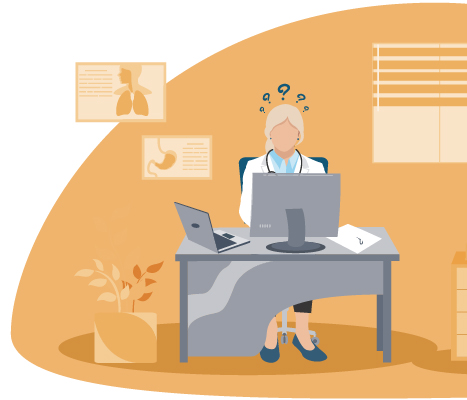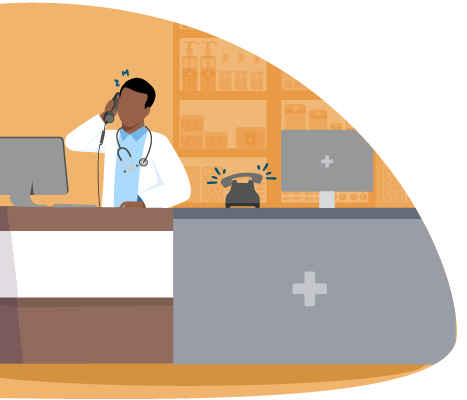Turn barriers

into breakthroughs with simpler health intelligence sharing

Faxes. Phone calls. Emails. Paperwork.
Everyday disruptions can cause treatment delays for patients and frustration for everyone involved in their care, from prescribers and pharmacists to health plans, pharmacy benefit managers and population health teams.
But what if you could break through common communication barriers and help deliver exceptional care with less struggle?
See how the Surescripts Network Alliance® is making it happen.
Primary care visit

A physician is preparing to see a new patient from out of state. But without clinical documentation or medication history from the patient’s previous providers, it’s hard to get a clear picture of the treatment he’s already received.

The physician prescribes a specialty medication that requires prior authorization. She crosses her fingers that her support staff can easily find the correct form—and that the cost will be affordable for the patient.

While trying to squeeze in lunch, the physician gets a phone call: The prescription she sent can’t be filled because the specialty pharmacy needs more information.
At the hospital emergency department

Weeks later, the patient arrives in the emergency department by ambulance unconscious, and the care team doesn’t know which medications he’s taking or where he’s been treated in the past.

The patient is ready to be discharged, and the emergency department doctor has important follow-up information for his primary care provider. But for some reason, the fax isn’t going through.

The patient leaves the hospital with a new medication regimen, and the emergency department doctor needs to make sure an old medication is not refilled. Better call the pharmacy to be safe … and try to tune out the hold music.
At the pharmacy

At the pharmacy, a patient trying to pick up his prescription is shocked by the high cost. The pharmacist thinks she can help find another option, but it’ll involve a lot of back-and-forth between the patient, prescriber and health plan.

The pharmacist gets another prescription—but it needs prior authorization. Time to try to get the prescriber on the phone.

Over at the specialty pharmacy, a pharmacist discovers that the patient’s weight is missing, so she can’t confirm the correct dose. Another phone call goes on the to-do list.
Behind the scenes

A care manager makes a phone call to check that a patient has filled her diabetes prescription, but her voicemail is full.

A surprising claim for a hospital visit reaches the patient’s health plan. Her care manager there scrambles to track down more details so he can provide appropriate outreach and help prevent duplicate therapy.

The health plan is updating its formularies, and there are serious cost implications for many members. The health plan mails out a notice to their members’ providers, but there’s no way to know how many will get it in time to take action.
What breakthroughs can we create for your team?
Tell us a little about your organization and the challenges you’re trying to solve, and we’ll connect you with experts who can help.
In 2022, Surescripts Record Locator & Exchange helped identify 1.25 billion links to clinical document sources.
Source: Surescripts, “2022 National Progress Report,” March 2023, p. 10.
One study of prior authorization technology including Surescripts Electronic Prior Authorization found that it cut the average time from request to decision by more than two-thirds.
Source: Denise Clayton et al., “Evaluation of the Fast Prior Authorization Technology Highway,” Journal of the American Pharmacists Association 62, no. 6 (November 2022): 1843–1847.
A 33% increase in prescriber enablement for Specialty Patient Enrollment in 2022 meant more patients could start treatment sooner.
Source: Surescripts, “2022 National Progress Report,” p. 10.
Medication History for Reconciliation enriches the average patient-reported history by 28%, adding 1.1 drugs per patient that would have otherwise been missed.
Source: Kin Wah Fung et al., “Comparison of Electronic Pharmacy Prescription Records with Manually Collected Medication Histories in an Emergency Department,” Annals of Emergency Medicine 62, no. 3: (May 20, 2013), 205–211.
Healthcare professionals and organizations exchanged 174.8 million Clinical Direct Messaging transactions in 2022.
Source: Surescripts, “2022 National Progress Report,” p. 7.
When one health system implemented CancelRx, the rate of discontinued medications that were successfully canceled at the pharmacy rose from 34% to 93%.
Source: Taylor L. Watterson et al., “CancelRx Implementation: Observed Changes to Medication Discontinuation Workflows Over Time,” Exploratory Research in Clinical and Social Pharmacy, January 25, 2022.
Prescribers using Real-Time Prescription Benefit to find a more affordable alternative saved patients an average of $61.17 per prescription in 2022.
Source: Surescripts, “2022 National Progress Report,” p. 8.
More than 80% of e-prescribers were enabled for RxChange in 2022, joining 89.9% of pharmacies.
Source: Surescripts, “2022 National Progress Report,” p. 5.
One large specialty pharmacy cut average time to fill by more than two days by implementing Specialty Medications Gateway.
Source: Cecelia Byers, “How Accredo Shaved 2 Days Off Its Turnaround Time for Specialty Prescriptions,” Intelligence in Action, February 14, 2022.
In one population health program, Medication History for Populations helped reduce the need for 90-day follow-up calls by approximately 20%.
Source: Surescripts, “How Medication History Helps Parkland Health & Hospital System Avoid Readmissions and Pinpoint Nonadherence,” 2021, p. 1.
76% of care locations in the U.S. have clinical events identifiable by Surescripts.
Source: Surescripts analysis of 2022 average monthly care locations identified by Surescripts Record Locator & Exchange compared to total known U.S. care locations, as calculated using Surescripts network data and data provided by National Plan & Provider Enumeration System, Definitive Healthcare and the Carequality directory, 2022.
Health plans and pharmacy benefit managers covering nearly 220 million patients nationwide used Clinical Direct Messaging in 2022 to improve care quality and communication with providers.
Source: Surescripts, “2022 National Progress Report,” p. 7.
